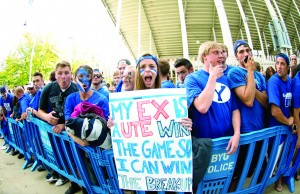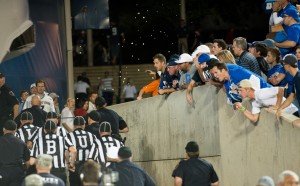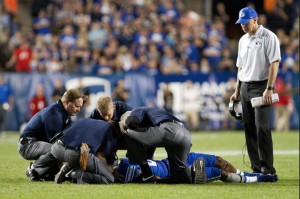It’s Nov. 30, 2013. Helmets fly and fists connect with faces. Just 20 seconds ago, they were playing football.
Now they’re pummeling each other in an all-out brawl. Referees and coaches enter the melee, eventually clearing up the fight. Three players are ejected. One flashes a pair of obscene gestures at the crowd on his way out.

Why?
Because it’s Ohio State vs. Michigan — a rivalry older than the grandfathers of this year’s participants.
“It’s a big deal,” said Ron Burdge, a member of Ohio State’s class of 1949. “Sometimes it felt like the only truly important game of the year.”
Rivalries give place to silly traditions. They bring communities together. They fill stadiums and give fans a reason to care even in mediocre seasons. But in 2013s edition of “The Game,” the annual hate-fest crossed a line and went to an ugly place where rivalries venture all too often.
Rivalries bring tolerance to a different level
Had the fight happened in a different game, say, the Sept. 21 match-up of Ohio State and Florida A&M, people would’ve seen it differently. Players would’ve been tagged with multiple-game suspensions. Ohio State would be viewed as a football team full of thugs. But players, coaches and fans expect misbehavior during rivalry week. They expect a different level of tolerance toward misbehavior. Ohio State head coach Urban Meyer confirmed this when he addressed the ejection of two Ohio State players.
“That’s a tough penalty for a rivalry game,” he said.
For a rivalry game.
Brigham Young University is a school known for its strict honor code, which aligns itself with the teachings of The Church of Jesus Christ of Latter-day Saints. Students render service. They dress modestly. A visitor would seldom hear a curse word during a weekend stay in Provo.
Yet, this year’s “Holy War” between BYU and Utah saw BYU fans pelting referees with hot dogs and garbage as Utah walked off the field with a 20-13 victory.
On the other hand, BYU fans are usually quick to point out the misconduct of the other side.
“They’re classless,” BYU student and fan David Jeffs said. “They shout ‘BYU sucks’ during the prayer before the games.”
In the 90s, Utah fans notoriously wore shirts to games against BYU with an apparent foam finger on the back. The foam finger had the middle finger up instead of the pointer finger, with B-Y-U stamped on the center of the hand.
In examination of the rivalry, both teams have displayed classlessness at one point or another. Yet, some students from both schools insist the rivalry is a good thing, and wish it would continue in the years to come. Their attitude reflects their tolerance for rivalry’s antics on and off the field.
“I think the rivalry is good for both schools,” Utah student and fan Elise Vandersteen said. “I love the game and want them to play against each other every year.”
And that’s how many see it. They can forgive the offensive t-shirts, the interruptions to prayers and the flying hot dogs. To them, the rivalry is wonderful. After all, it presents the opportunity to beat a team they truly hate.

Rivalry brings communities together
Rivalries aren’t inherently bad. Some of their traditions are as old as the schools themselves, and have brought communities together.
At Princeton, players and fans celebrate when the Tiger football team beats Yale and Harvard in the same season by building a giant bonfire on Cannon Green, a lawn on the south end of campus. In 2013, Princeton fans, alumni and former players were able to watch the bonfire celebration live through the internet for the first time.
The bands of Southern and Grambling highlight the Bayou Classic. The two proud bands fight to outplay one another when the two schools meet to play football each year. Many people attend the game just to see the bands duke it out in New Orleans.
When Auburn beat Alabama in football, the Auburn community used to gather at Toomer’s Corner in downtown Auburn to hurl toilet paper rolls over the branches of two giant oak trees. The party would last through the night and eventually the trees were white as snow. Two and a half years ago, the rivalry turned ugly, as an Alabama fan allegedly poisoned the two trees. Local horticulturists declared the trees wouldn’t survive and the trees had to be removed, ruining a great rivalry tradition.
When rivalries turn deadly
Sometimes the actions surrounding sports rivalries go far past insults about an opponents’ mother or minor vandalism. On Sept. 28, 2013, a post-game confrontation between Dodgers fans and Giants fans resulted in death as a 24-year-old Dodger fan, Jonathan Denver, was fatally stabbed. It was reported Denver had yelled “Giants suck!” to the group wearing San Francisco hats to incite the confrontation.

Denver’s death is not the only horrific incident from the Dodgers and Giants rivalry. According to the Wall Street Journal, there have been at least two other incidents between Dodgers and Giants fans resulting in death, and it’s generally accepted that post-game rivalry violence was a main motive in the Giants’ move from Candlestick Park to AT&T Park in San Francisco.
Some rivalries have gotten to the point where small acts of violence or vandalism are the norm each year, with utter tragedies occurring every few years.
Burdge said violence related to rivalries is a growing trend.
“Back then (referring to 1946-1949, when Burdge attended Ohio State) it seemed like there was plenty of hatred, but that all came out on the field,” he said. “Now the violent acts come out between fans before and after the games.”
Time to cancel the games?
In 2013, the CIAA championship featuring Winston-Salem and Virginia State was slated for Nov. 15. On the eve of the game, a banquet was held between the two programs. When Winston-Salem quarterback Rudy Johnson left the banquet to go to the restroom, Virginia State players ganged up on him and beat him up.
The CIAA and the two programs set a precedent by canceling the impending championship game. Additionally, a volleyball match between the two schools also scheduled for the next day was canceled.
Players from both schools were disappointed they wouldn’t be able to play for the championship, but former BYU football player Grant Thorsen said canceling the game is the price athletes should pay for inappropriate actions.
“Our coach always told us to let our anger out on the field,” Thorsen said. “If you can’t do that, the rivalry isn’t a good thing anymore.”




